Interview with Chef Ken Oringer of Clio in Boston, MA and a recipe for Earth Crab Toast
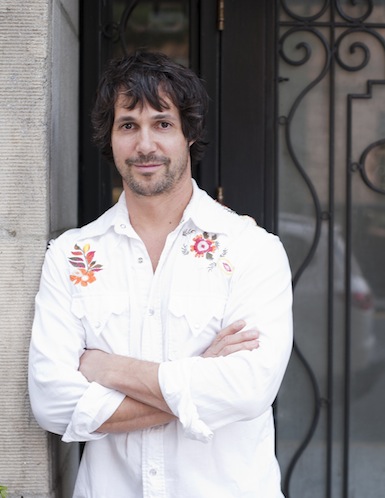
What topics do you discuss in an interview on board a cruise ship with a critically acclaimed chef that owns six successful restaurants and will soon open his seventh, was named a Best Chef Northeast (2001) by the James Beard Foundation, has won Iron Chef, worked with some of the most famous chefs in the world and is the recipient of the 2010 Chefs Rising Stars Mentor Award for his commitment to inspire and teach the next generation of chefs? You talk about travel, restaurants, and tracking down some of the best markets and hidden food gems in the Mediterranean.
Ken Oringer, chef and owner of Clio, Uni, Toro, La Verdad, and Coppa in Boston and Earth in Kennebunkport, Maine was guest chef on board Holland America’s Nieuw Amsterdam Mediterranean Empires cruise in June. Arriving on board with his family several days after our departure from Venice, following an elaborate 15 year anniversary celebration at Clio, his highly acclaimed fine dining establishment in Boston, Oringer was also awaiting news about the fate of his Boston Celtics who were in the NBA Finals (they didn’t win).
While two cooking demonstrations were scheduled on board the ship for Chef Oringer, this cruise was also a family vacation and a quick break before heading back to Boston to focus on another new restaurant to add to his empire. Oringer will be opening a second Toro (his Barcelona-style tapas restaurant) in New York City.
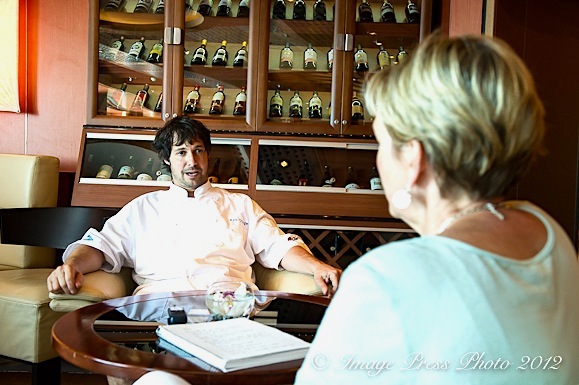
With Chef Ken Oringer on board the Nieuw Amsterdam
“I grew up in New Jersey (Paramus) and started my training in New York, so it was natural for me to take Toro there. I push myself to have high standards. I do what I do and hopefully they (New Yorkers) will like it.” Why did he choose the meat packing district for this new venture? “It’s up and coming and we were able to get great space with 30 foot ceilings. It’s a newer area (of town). We will seat 110 in the dining room, have a charcuterie room downstairs and seat another 45 (downstairs) with a few private dining rooms.”
In addition to working on the new restaurant, Oringer’s flagship restaurant in Boston, Clio, recently underwent a facelift prior to the big anniversary celebration. “I was tired of going to the same restaurant everyday, so I was ready for a change. We need to keep it fresh. It is important for the team to believe it’s fresh, too. We also want to make our guests feel special at the restaurant. I push to create something different and separate myself from the pack.”
“The atmosphere (at Clio) is New York meets San Francisco. It’s comfortable. People come more often without jackets than with them, especially these days.” The day when people dressed for an evening of fine dining has changed. Even the finest restaurants routinely see more casual or “business attire.”
Celebrating Clio’s 15th anniversary in style, Oringer invited 15 former cooks (many who have become celebrated chefs in their own right) back to the restaurant to prepare 15 courses for a four-hour feast with 100 guests, including good friend and fellow Boston chef, Ming Tsai and partner/chef of Coppa, Jamie Bissonette.
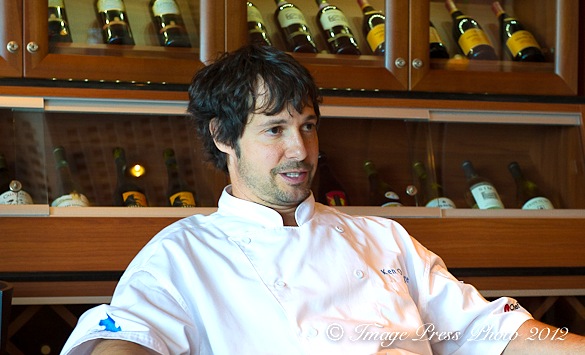
Chef Ken Oringer
Oringer’s favorite pastime and inspiration for his innovative dishes and restaurant concepts is travel and he travels extensively. His travels influence not only the food he prepares at his restaurants but his business ventures as well. Working with Ferran Adrià (chef/owner of the world famous and top rated restaurant, El Bulli, in Catalonia, Spain) 14 years ago was the motivating force in creating Toro. “Tapas were new then. There were no great tapas in the United States at that time. I love the social aspects of that style of dining.” Adrià closed El Bulli last year, after 25 years, in order to move to New York, but the impact of his legendary restaurant and its influence on so many chefs remains.
Three years ago, when we traveled to Spain, the tapas in Barcelona were unlike anything we had experienced in this country. The trend appears to be expanding in the United States as we have recently seen a few authentic tapas restaurants open with menus that closely resemble the style of tapas we found in Spain.
“I love the places I have traveled to…France, Mexico, Japan (to name a few), and I have been to them many times. I have a sensibility much different than traditional say, Japanese chefs. I would open up a Japanese restaurant serving fish from France and Chile and incorporate local products. I can do things that are more broad. I don’t think I will open a kebob house tomorrow (referring to our cruise stop in Istanbul), but it is the flavor profiles and memories of those places that mean a lot to me. I will use the Marash peppers and Leppo peppers (found in Istanbul) and incorporate them into dishes. For instance, at Toro, I might create Abalone a la plancha with Turkish pepper.”
We did catch glimpses of Chef Oringer out and about with his family while in several of the ports and while it was tempting to tag along with him knowing that he would find the best spots to dine, we respected his family time, so we knew we would have to hear about the missed food opportunities later… and we did. Twice. He shared with us his iPhone photos of food from various ports. We should have just stalked him for good food and lived with the consequences.
“The fish market in Kusadasi looked like Barcelona.” Thrilled at his find, he showed us the images. “They had giant and baby squid, two kinds of crab and three kinds of shrimp, Albacore and regular tuna. It was pristine.” Rather than going to a restaurant and ordering dinner, Oringer purchased his fish at the market and took it to a local chef to prepare. Now we know what to do next time we are in Kusadasi. Fresh shrimp, Dorado and Sea Bream from the market to the restaurant next door. Nothing like creating your own menu at another chef’s restaurant.
Mykonos, Greece also was a find for Oringer. An unusual seasoning in a sausage he had for lunch was “phenomenal” and a small Italian restaurant where his family dined that evening were his highlights from this gorgeous island. “I have made tuna meatballs before, but this pasta dish was incredible. Little tuna meatballs with fresh sardines, mint, pecorino, Greek olive oil and blistered cherry tomatoes.” It was the second time I heard him describe this dish and both times he lit up remembering the flavors and elements of the dish. “It was as good as anything I have had in Italy.”
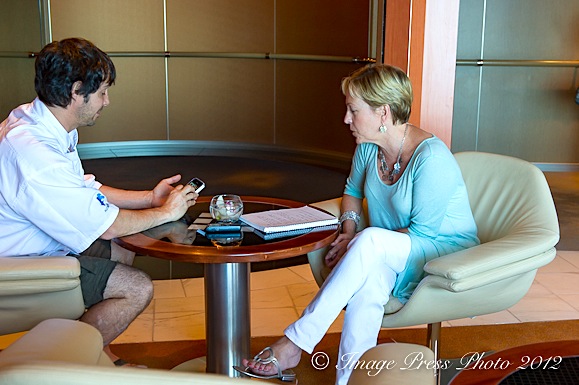
I knew we should have stalked him in the ports.He found all the great markets.
With travel playing the primary role in Oringer’s creativity and the innovation behind his restaurant concepts, what does he think will be the next food trend. “Specific regionality. People are demanding what is specific and authentic, say from a specific region of China or Venetian only Italian. Only Basque style Spanish or Kyoto style Japanese food. People want micro regions of food because they are not happy with food as it is.”
“A lot of chefs are coming to the states (from abroad) and it doesn’t matter how small of a town they are coming from. They can express themselves from places in China or Europe. They can get an audience. Andy Ricker (of Pok Pok in Portland) just opened Pok Pok NY in Brooklyn in the middle of nowhere. It’s authentic. Go inside and you feel like you’re eating in Bangkok”.
Chefs are deciding, “This is who I am, this is the food I cook and I’m just going to do it. Thanks to the internet you can find an audience and not just cook for the masses.”
Oringer is no stranger to creating unusual dishes that will appeal to a more sophisticated and educated palate. What comes to mind is one of the dishes he created in the battle of coffee against Iron Chef Cat Cora in his fanciful take on breakfast. A soft-cooked egg prepared sous-vide, with the runny yolk slowly easing its way through a combination of coffee-infused trumpet royale mushrooms and a parsley root purée, finished with a Spanish jamon-flavored foam and a bit of Périgord black truffle vinaigrette and caramelized Indian-spiced brioche dusted with ground coffee.
“My travel influences help separate me from the pack. I like serving dessert with mangosteens when nobody knows what the heck a mangosteen is. I like to travel to other parts of the world where I can take advantage of the foods there and create something that I like that is unusual with ingredients I can’t find anywhere else.”
We chatted about Boston when not discussing travel and food. Having lived in the city when Clio first opened, I remember the restaurant well and had personally experienced the early beginnings of Oringer’s culinary success. I mentioned to him that I missed the city and would like to move back some day. However, my objection is the cold weather. “Oh, come on. It’s not that cold. It’s not like you’re out hiking every day. I walk to work and then I’m inside all day.” True. It’s just that you have to get there. In the winter.
Oringer and his family were disembarking a few days early to spend extra time in Croatia. I wondered what the food focus would be in this country. “Seafood?” I asked. He replied, “Suckling pig and seafood.” Maybe we should have palled around with him in Croatia to see what he discovered there. Better yet, I think I will head to Boston to see what is new on his menus. I imagine there will be something that was inspired by his recent travels to the Mediterranean.
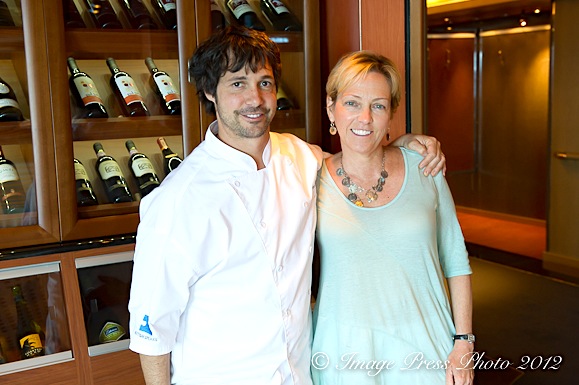
Our next stop is Clio to see what he discovered in Croatia
Thank you so much to Chef Ken Oringer for taking the time to meet with us while on board the Nieuw Amsterdam. It was a pleasure to spend some time with him and to meet his family. If you would like to know more about him, you can read his complete bio here. I will also be sharing a cooking video of Chef Oringer from the cruise in my next post.
Earth Crab Toast is a recipe from his restaurant Earth at Hidden Pond in Kennebunkport, Maine. This restaurant’s concept of “farm to fork” utilizes many ingredients picked fresh from the restaurant’s own farm, local purveyors and fresh seafood from New England.
This dish is perfect as a first course when entertaining. There are a few steps involved in making the sauces, but they can be done ahead. It calls for peekytoe (pronounced “picket toe”) crab but you can substitute lump crab if peekytoe is not available. Peekytoe is a Maine rock crab noted for its leg that has a sharp point that turns inward. Once considered a throwaway by lobster farmers, it is now highly sought after by chefs.
A quick homemade version of cocktail sauce worked well for this dish (rather than making the sauce as in Chef Oringer’s recipe). We combine ketchup, horseradish, Worcestershire and freshly squeezed lemon juice, to taste. We like the sauce to be a bit hot, so we use quite a bit of horseradish. I did prepare a recipe for aïoli and made the French Cocktail sauce. The combination of these sauces and flavors layered together with the crab meat, avocado, and toasted baguette was outstanding. I did not make a salad as the final garnish for the toast since I was serving an arugula salad for dinner that evening. I did, however, use a single piece of arugula which added a nice peppery component to the dish.
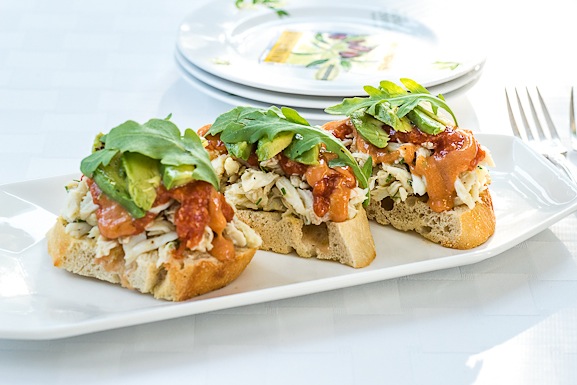
Earth Crab Toast
* Photograph at the top of the post is courtesy of Clio – Boston, MA
This content is protected under International Copyright Laws. No part (text or images) may be copied or reproduced without the express written permission of bunkycooks.com. All rights reserved.
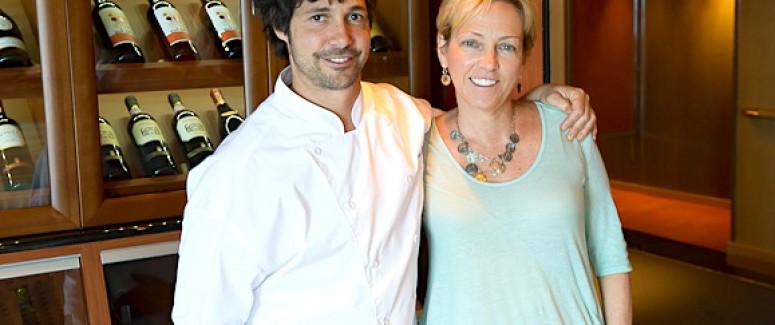
Earth Crab Toast
The crab toast is a popular dish at Earth, inspired by a trip to Cape Cod by Chef Oringer.
* If you make the recipe for the traditional cocktail sauce, you will need to allow more time for preparation and cooking. I made a quick version of homemade cocktail sauce as noted below.
Ingredients:
Ingredients:
1 loaf of country, crusty baguette
8 ounces of peekytoe crab meat (I used lump crab meat as peekytoe crab was not available)
1 ripe avocado
French cocktail sauce (recipe below)
Traditional cocktail sauce (recipe below) *We used a quick homemade version with ketchup, prepared horseradish, Worcestershire sauce, and freshly squeezed lemon juice.
Petite greens and garnishes
Sauce Methods:
French cocktail sauce is a compilation of many condiments. If made correctly, it is a pale, peachy, brown color. It works wonderfully on this dish as well as a dressing for steak tartare. This sauce should be made to fit your own taste. It consists of the following:
3 Tablespoons ketchup
2 Tablespoons Dijon mustard
1/2 teaspoon Tobasco
3 Tablespoons aïoli
2 Tablespoons Cognac
Traditional cocktail sauce at Earth is made from our own ketchup and fresh grated horseradish, along with a little lemon juice:
2 cups of sugar
2 cups of champagne vinegar
1 #10 can of riced, San Marzano tomatoes
Salt to taste
Grated horseradish
Lemon juice
Crab Salad:
It is important to repick any crab you buy to make sure shells and cartilage are removed.
Once picked, dress with the following:
3 Tablespoons aïoli
2 Tablespoons fresh lemon juice
Fresh chopped herbs of your choice; we use mint, dill, opal basil, a little bit of cilantro and chives
Salt and Pepper to taste
Directions:
For traditional cocktail sauce:
Make a medium colored caramel with 2 cups of sugar. Use enough water to make wet sand. Add in 2 cups of champagne vinegar and 1 #10 can of riced, San Marzano tomatoes. Cook down slowly until it reaches a ketchup consistency. Salt to taste.
Once cooled, add in your grated horseradish and a little lemon juice.
To assemble the toast:
Cut 4 center-cut slices from your baguette. Trim the two long sides and dress with a little olive oil, salt and pepper. Grill both sides of the bread until toasty.
Put 2 ounces of your crab salad on each toast.
Dress the crab with both your French and traditional cocktail sauce.
Thinly slice your avocado and shingle it onto the crab meat.
Make sure to lightly dress your avocado with olive oil, lemon salt and pepper.
Make a salad of petite greens (arugula works well), torn herbs and edible flowers to garnish.
Chef Ken Oringer
Clio – Boston, MA and Earth – Kennebunkport, ME